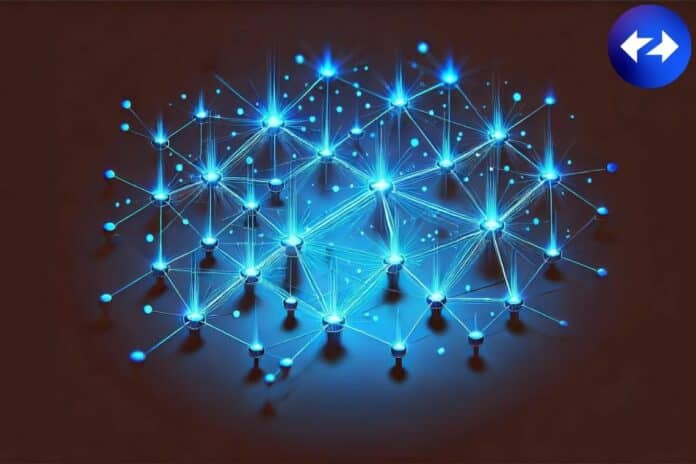On June 7th, the layer-2 ZKsync released an update that transforms ZKsync from a single chain to an “elastic chain”.
The team of Matter Labs, the leading development company behind the ZKsync network, stated it.
Summary
ZKsync announces the new Elastic Chain
So for a few weeks now ZKsync has been calling itself Elastic Chain.
Thanks to the update on June 7 (v24), the roadmap leading to ZKsync 3.0 has been initiated, which is the project to make its ecosystem more interconnected.
The Elastic Chain can be compared to the AggLayer of Polygon, another layer-2 of Ethereum.
Thanks to this innovation, ZKsync transforms from a single zero-knowledge (ZK) rollup chain to a network of multiple ZK chains with native interoperability among them, and a unified user experience.
The objective is always to create a cross-chain ecosystem capable of making different chains interact with each other, something quite difficult to do currently.
According to the ZKsync development team, the new architecture of the elastic chain provides seamless operation between the various chains, similar to how one can operate on a single blockchain.
For example, transactions will only require the confirmation of a single wallet, and there will no longer be a need to change networks or manually bridge assets.
The first rollup of the new Elastic Chain, ZKsync Era, has already been launched, and it serves as a fundamental layer of this new ecosystem that in the future will comprise over 20 chains. These are expected to be operational on the mainnet by the end of 2024, and should involve Lens Protocol, QuarkID, PlayFi, GRVT, Cronos zkEVM, Nodle, and other crypto projects.
The Elastic Chain will be a consistent multichain environment, allowing intuitive operation on different chains in a manner similar to how it is currently done on a single chain. Additionally, interaction with smart contracts will be simplified thanks to the Ethereum Multi-Chain Address (EMCA) standard, designed to simplify the identification of addresses across various chains.
ZKsync Era
zkSync Era is a project launched in 2022 and that has now finally become a reality.
Currently, it has a TVL of about 122 million dollars, which is slightly less than dYdX, but already more than Celo, EOS, MultiversX, or Fantom.
To tell the truth, however, most of this TVL was accumulated between April and July of last year, so much so that starting from July 2023 it had begun to lose some ground.
After a new boom in March of this year, due to the boom of the crypto market, it started a descending phase again. However, with the update on June 7, it could start a new path capable of giving new life to the project.
ZKsync also has its own native token, ZK, launched precisely with the update on June 7.
The historical data on the markets is too limited to make a judgment, but from the launch price, it has lost 43% in about two weeks so far.
On the other hand, the launch of this token was carried out with an airdrop, so it is more than natural that many of those who received it as a gift decided to monetize it immediately by using it to acquire stablecoin or other crypto.
Matter Labs
The company behind the ZKsync project is called Matter Labs.
Last year the company released its ZK Stack, a toolkit that allows developers to create their own custom blockchains based on ZKsync technology, and now with the update to v24 these chains will all be interconnected with each other.
According to Matter Labs, the new Elastic Chain will be an infinitely extensible network of ZK chains interoperable with each other thanks to an intuitive and uniform user experience.
The new Elastic Chain will be composed of three main components, namely the “Native Token Vault”, the “Router condiviso” and the ZK Gateway.
It is about smart contracts on Ethereum responsible for managing the state of the network and handling registrations.
In particular, ZK Gateway is a middleware that connects the Ethereum blockchain to the ZKsync chains, allowing interoperability between the different chains.
The project is quite complex, and at the current stage, it is aimed almost exclusively at developers. The hope is that it can become a shared development substrate to the point of becoming a standard in the future.
ZKsync aims for interoperability between chains with Elastic Chain
Until now all the main blockchains have been designed to operate independently, autonomously, and disconnected from the others.
For example, you cannot use the Ethereum network to move real BTC.
The solutions currently in use to overcome this problem often involve the use of bridges, which, however, are not always secure, and above all, each works in its own way.
To achieve widespread and easy-to-use interoperability between various blockchains, it is necessary to experiment with other solutions, such as ZKsync’s Elastic Chain or Polygon’s AggLayer.
The goal is to allow even non-expert users to use multiple chains simultaneously in an easy and secure way, given that at the current state it is not easy at all, and there is always the risk that it might not even be particularly secure.
To tell the truth, similar solutions have been under study for years, and so far no one has managed to produce an effective one. ZKsync and Polygon are not the only ones working on it, but probably those who already have several users operating on their platform certainly start from a point of advantage.
Polygon, for example, has a TVL that exceeds 800 million dollars, and among Ethereum’s layer-2 solutions, it is surpassed only by Arbitrum (2.7 billion) and Coinbase’s Base (1.5 billion).




